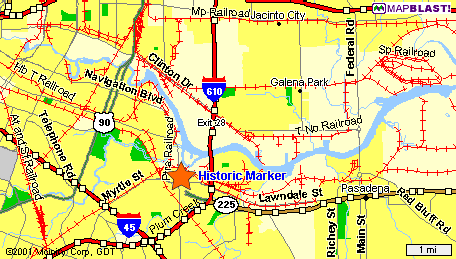Texan
Capture of Mexican Dispatchers
|
Marker Title: |
Texan Capture of Mexican Dispatches (San Jacinto) |
|
Address: |
Bellaire Blvd. at Second St. |
|
City: |
Bellaire |
|
County: |
Harris |
|
Year Marker Erected: |
1989 |
|
Designations: |
na |
|
Marker Location: |
|
|
Marker Text: |
The San Jacinto campaign in southwest Harris County. After the
fall of the Alamo on March 6, 1836, Gen. Sam Houston led the
Texan army in retreat from Gonzales. The Mexican army under Gen.
Santa Anna followed eastward from San Antonio. On April 14, while
Houston's army was north of him, Santa Anna led a division of
his army from the Brazos River near present Richmond to Harrisburg.
He crossed present southwest Harris County, then an uninhabited
prairie, and reached Harrisburg (12 miles east of this site)
on April 15. The Mexicans burned Harrisburg on April 17 and continued
marching east. Houston's army, arriving at Buffalo Bayou opposite
Harrisburg on April 18, found the town in ruins, but did not
know the whereabouts of the Mexican army. That day, Texan scouts
led by Erastus "Deaf" Smith captured thee Mexicans,
including Capt. Miguel Bachiller, a courier, and a guide in this
vicinity. The prisoners and their dispatches revealed the location,
size, and plans of the Mexican army. With this vital intelligence,
Houston intercepted Santa Anna's March on april 20 and defeated
his division with a surprise attack on April 21 at the San Jacinto
River. The Battle of San Jacinto ended the Texas Revolution and
secured the independent Republic of Texas. Sponsored by the Bellaire
Historical Society |
|
Harrisburg,
Old
|
Marker Title: |
Old Harrisburg |
|
Address: |
8100 block of Lawndale at Frio |
|
City: |
Houston |
|
County: |
Harris |
|
Year Marker Erected: |
1965 |
|
Designations: |
na |
|
Marker Location: |
Frost Bank |
|
Marker Text: |
Early Texas port and trading post. Site of state's first steam
saw, grist mills and railroad terminal. Town founded, 1826, by
John R. Harris, who was first settler in 1823. Became shipping
center for early colonies, established when Texas was part of
Mexico, with boats carrying cargo to and from Texas ports and
points in the United States and Mexico. Became the seat of government
of the Republic of Texas, March 22 - April 13, 1836, when David
G. Burnet, President of the ad interim government and several
of his cabinet resided near here in the home of Mrs. Jane Harris
(site marked), widow of town founder. Here President Burnet adopted
the flag for the Texas Navy. In 1835, local resident, Mrs. Sarah
Dodson, had made here the first tri-color lone star flag. General
Santa Anna attacked the town with 750 Mexican soldiers on April
16 attempting to capture Burnet and his cabinet. The whole town
was burned. After Texas gained its independence at nearby San
Jacinto, the town was rebuilt and again thrived. The Buffalo,
Bayou, Brazos and Colorado, first railroad in Texas began here
in 1852 and by the Civil War made the town a Confederate rail
center. Became a part of Houston, by annexation, in 1926. |
|

